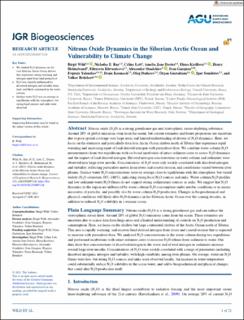| dc.contributor.author | Wild, Birgit | |
| dc.contributor.author | Ray, Nicholas E. | |
| dc.contributor.author | Lett, Céline | |
| dc.contributor.author | Davies, Amelia Jane | |
| dc.contributor.author | Kirillova, Elena | |
| dc.contributor.author | Holmstrand, Henry | |
| dc.contributor.author | Klevantceva, Elizaveta | |
| dc.contributor.author | Osadchiev, Alexander | |
| dc.contributor.author | Gangnus, Ivan | |
| dc.contributor.author | Yakushev, Evgeniy | |
| dc.contributor.author | Kosmach, Denis | |
| dc.contributor.author | Dudarev, Oleg | |
| dc.contributor.author | Gustafsson, Örjan | |
| dc.contributor.author | Semiletov, Igor | |
| dc.contributor.author | Brüchert, Volker | |
| dc.date.accessioned | 2023-09-21T14:16:20Z | |
| dc.date.available | 2023-09-21T14:16:20Z | |
| dc.date.created | 2023-06-14T14:41:19Z | |
| dc.date.issued | 2023 | |
| dc.identifier.citation | Journal of Geophysical Research (JGR): Biogeosciences. 2023, 128 (5), e2022JG007326. | en_US |
| dc.identifier.issn | 2169-8953 | |
| dc.identifier.uri | https://hdl.handle.net/11250/3091142 | |
| dc.description.abstract | Nitrous oxide (N2O) is a strong greenhouse gas and stratospheric ozone-depleting substance. Around 20% of global emissions stem from the ocean, but current estimates and future projections are uncertain due to poor spatial coverage over large areas and limited understanding of drivers of N2O dynamics. Here, we focus on the extensive and particularly data-lean Arctic Ocean shelves north of Siberia that experience rapid warming and increasing input of land-derived nitrogen with permafrost thaw. We combine water column N2O measurements from two expeditions with on-board incubation of intact sediment cores to assess N2O dynamics and the impact of land-derived nitrogen. Elevated nitrogen concentrations in water column and sediments were observed near large river mouths. Concentrations of N2O were only weakly correlated with dissolved nitrogen and turbidity, reflecting particulate matter from rivers and coastal erosion, and correlations varied between river plumes. Surface water N2O concentrations were on average close to equilibrium with the atmosphere, but varied widely (N2O saturation 38%–180%), indicating strong local N2O sources and sinks. Water column N2O profiles and low sediment-water N2O fluxes do not support strong sedimentary sources or sinks. We suggest that N2O dynamics in the region are influenced by water column N2O consumption under aerobic conditions or in anoxic microsites of particles, and possibly also by water column N2O production. Changes in biogeochemical and physical conditions will likely alter N2O dynamics in the Siberian Arctic Ocean over the coming decades, in addition to reduced N2O solubility in a warmer ocean. | en_US |
| dc.language.iso | eng | en_US |
| dc.publisher | Wiley | en_US |
| dc.rights | Navngivelse 4.0 Internasjonal | * |
| dc.rights.uri | http://creativecommons.org/licenses/by/4.0/deed.no | * |
| dc.title | Nitrous Oxide Dynamics in the Siberian Arctic Ocean and Vulnerability to Climate Change | en_US |
| dc.type | Peer reviewed | en_US |
| dc.type | Journal article | en_US |
| dc.description.version | publishedVersion | en_US |
| dc.rights.holder | © 2023 The Authors | en_US |
| dc.source.pagenumber | 21 | en_US |
| dc.source.volume | 128 | en_US |
| dc.source.journal | Journal of Geophysical Research (JGR): Biogeosciences | en_US |
| dc.source.issue | 5 | en_US |
| dc.identifier.doi | 10.1029/2022JG007326 | |
| dc.identifier.cristin | 2154548 | |
| dc.source.articlenumber | e2022JG007326 | en_US |
| cristin.ispublished | true | |
| cristin.fulltext | original | |
| cristin.qualitycode | 2 | |

